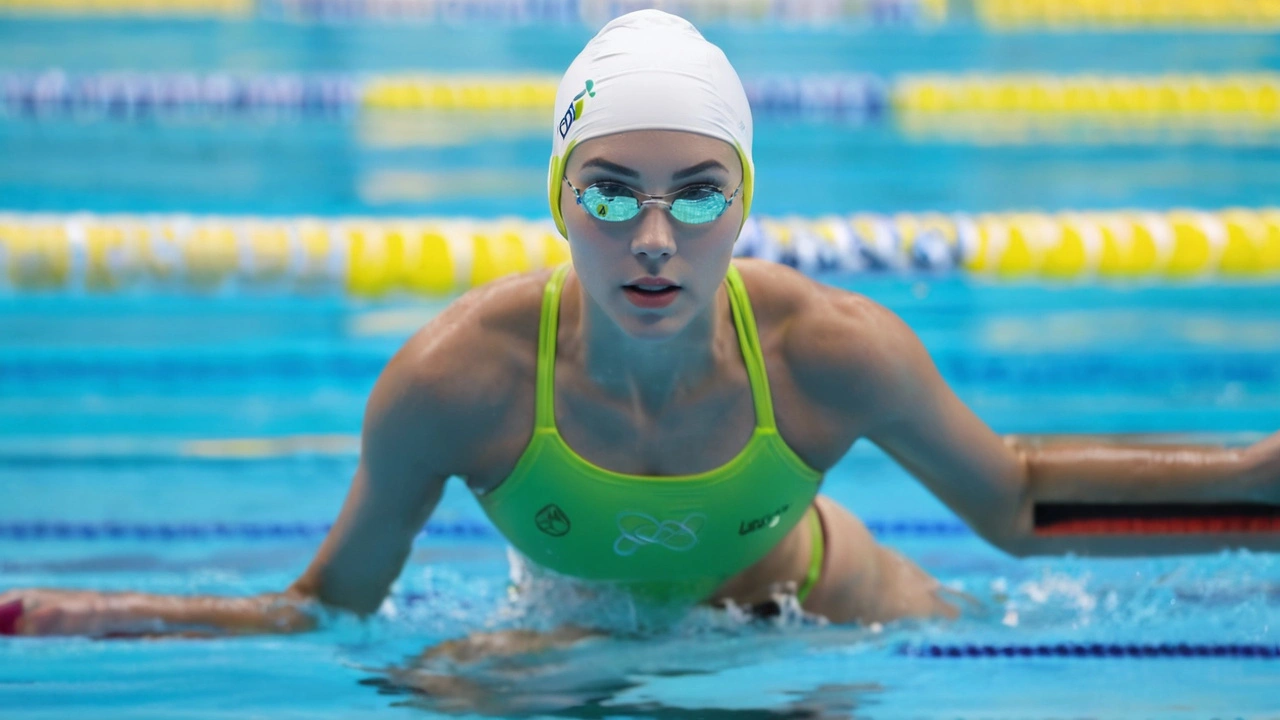The Evolution of Artistic Swimming: Strength Meets Elegance
Artistic swimming, once known as synchronized swimming, has undergone a dramatic transformation over the years. The sport, which captivated audiences with its elegance and grace, now demands a combination of strength, endurance, and flexibility akin to elite gymnastics. This metamorphosis is not just in the athletes’ physiques but is also embedded deep in the routines and performances that embody the very essence of artistic swimming today. So, what catalyzed this remarkable evolution?
The Shift from Synchronized to Artistic Swimming
It was in 2017 that the International Swimming Federation (FINA) decided to officially change the name from synchronized swimming to artistic swimming. The rationale behind this significant change was to better reflect the artful and expressive nature of the sport. However, this change was not merely semantical. It marked the onset of a new era in which athletes began to incorporate more complex and physically demanding routines.
Blending the elegance of traditional synchronized swimming with intense physical prowess, today's artistic swimming routines push the boundaries of what the human body can achieve in water. Performers today are not only expected to be in synchrony but also to execute acrobatic maneuvers that require immense core strength, flexibility, and precise timing.
Physical Demands and Associated Risks
The intricate movements and high-energy lifts and throws now associated with artistic swimming come with their fair share of risks. Athletes must possess a unique blend of strength and grace while also managing the potential for serious injuries. Common injuries include concussions from unintended collisions, broken bones from mistimed lifts or landings, and joint problems that arise from the repetitive strain put on the body.
One cannot ignore the psychological pressure these athletes face as well. The demands of artistic swimming extend beyond the physical; each performance must demonstrate technical precision while also captivating the audience emotionally. The duality of maintaining an artistic flair amidst rigorous physical demands makes this sport exceptionally challenging.
The Introduction of Male Athletes
Another significant development in the realm of artistic swimming is the inclusion of male athletes in team events at the Paris 2024 Olympics. This landmark change represents not only a stride towards gender inclusivity but also introduces a new dimension to the sport. The power and dynamism brought by male athletes are expected to complement the existing grace and elegance typically exhibited by female performers. This fusion has the potential to elevate the level of competition and bring a new excitement to audiences worldwide.
A New Judging System
The Paris 2024 Olympics will also see the implementation of a new judging system designed to reduce subjectivity. This system, which includes base marks and declared difficulty, has been tried and tested at recent World Championships and has already proved to make competitions more unpredictable and exciting. Under this system, judges assign scores based on pre-declared difficulty levels and the execution of moves, bringing a more standardized approach to scoring while maintaining the sport's inherent artistic integrity.
Examples from recent competitions, such as the 2023 Pan American Games, reveal how this system has introduced significant shifts in team standings. Teams now find themselves striving not only for flawless execution but also for innovative and daring routines that showcase higher levels of difficulty.
The Spectacle of Paris 2024
The upcoming Paris 2024 Olympics is set to be a milestone event for artistic swimming. The blend of male and female athletes, coupled with the new judging criteria, sets the stage for an electrifying and unpredictable competition. Audiences can expect to witness routines that push the boundaries of what is physically possible, all while maintaining the artistic expression that gave birth to the sport.
As artistic swimming continues to evolve, it epitomizes a unique blend of athletic performance and artistic storytelling. The sport's transformation from synchronized grace to a high-risk, muscle-intensive spectacle highlights the incredible journey of its athletes and their unyielding dedication. The Paris 2024 Olympics will undoubtedly be a testament to this evolution, showcasing the extraordinary talent and resilience of these performers on a global stage.







JAN SAE
Coaching the new wave of artistic swimmers is a thrilling challenge, because every session blends precision, power, and poetry, and we celebrate each micro‑second of flawless alignment, pushing athletes to explore deeper core engagement, while also nurturing their artistic expression, and yes, the risk factor adds an extra layer of excitement for both trainers and performers alike! The transition from purely aesthetic routines to high‑impact lifts demands a revamped conditioning program, incorporating plyometric drills, resistance training, and breath‑control exercises, all of which must be synchronized with musical phrasing, timing, and choreography, creating a holistic approach that feels almost cinematic! Watching a team execute a flawless lift, where the male swimmers provide a stable ballast and the female swimmers exhibit unparalleled flexibility, feels like witnessing a living sculpture in motion, and it fuels our desire to keep innovating, improving, and inspiring the next generation! So, every practice is a blend of science and art, and we embrace the chaos, the sweat, and the occasional splash, because that’s where true growth happens!
Steve Dunkerley
From a biomechanical perspective, the integration of high‑intensity acrobatic elements in artistic swimming necessitates meticulous analysis of hydrodynamic lift coefficients, muscular torque output, and neuromuscular coordination patterns, thereby elevating the sport's physiological demands to a level comparable with elite gymnastics. The implementation of periodized strength training protocols, emphasizing isometric core stabilization and eccentric loading of the shoulder girdle, directly translates to improved execution of overhead throws and synchronized rotations. Moreover, the adoption of sport‑specific respiratory conditioning, such as hypoxic interval sets, enhances apnea tolerance, allowing athletes to maintain composure during prolonged submerged sequences while preserving facial expression quality. These advancements, supported by peer‑reviewed research on aquatic performance metrics, underscore the symbiotic relationship between artistic expression and scientific rigor within contemporary competitive frameworks.
Jasmine Hinds
That new routine is pure energy :) The athletes look unstoppable, it feels like a wave crashing over the pool
Madison Neal
Observing the current choreography, one can appreciate how the integration of kinetic chaining and synchronized amplitude modulation contributes to both visual impact and scoring potential under the revised judging rubric. The emphasis on difficulty elements, such as quadruple lifts and complex hybrid positions, demands a refined proprioceptive awareness, which the teams cultivate through repetitive drill cycles and video‑feedback loops. Consequently, the performance quality not only reflects technical mastery but also conveys a narrative cohesion that resonates with judges and audiences alike.
John Crulz
Introducing male athletes adds a compelling dynamic to team formations, expanding the architectural possibilities of lifts and allowing for greater vertical displacement, which in turn raises the overall difficulty score while preserving the fluid aesthetic that defines the discipline. This inclusion also encourages a broader talent pool, fostering cross‑gender collaboration and challenging traditional gender norms within aquatic sports.
Anita Drake
The evolution of artistic swimming mirrors broader societal shifts toward embracing diversity, resilience, and interdisciplinary excellence. Historically, the sport was confined to a narrow definition of femininity, emphasizing grace over power, yet today it celebrates a spectrum of physical expression. By welcoming male athletes, the discipline not only diversifies its talent base but also sends a powerful message of gender inclusivity on a global stage. This inclusion resonates with audiences worldwide, who see in the mixed teams a reflection of contemporary values that prioritize equality and collaboration. Moreover, the new judging system, with its emphasis on declared difficulty and execution, aligns with the sport's artistic roots while rewarding innovative athletic feats. Athletes now train with multidisciplinary regimens, blending traditional ballet techniques with strength and conditioning protocols akin to those used in diving and gymnastics. Such cross‑training fosters a holistic development that enhances both muscular endurance and expressive storytelling, crucial for captivating performances. The cultural narrative embedded in each routine often draws from mythologies, contemporary issues, and personal stories, turning the pool into a living canvas. In Paris 2024, spectators can anticipate routines that fuse classical motifs with avant‑garde choreography, showcasing the sport's ability to evolve while honoring its heritage. The heightened risk associated with complex lifts underscores the athletes' dedication, as they balance safety considerations with artistic ambition. Medical teams now play an integral role, employing preventive strategies and rapid response protocols to safeguard performers during high‑impact sequences. This collaborative ecosystem-coaches, choreographers, physicians, and athletes-exemplifies the interdisciplinary spirit that defines modern artistic swimming. As the sport continues to push boundaries, it invites dialogue about the role of art in competition, challenging traditional notions of what constitutes athletic achievement. Communities worldwide are increasingly inspired to develop grassroots programs that encourage participation across ages, genders, and cultural backgrounds. Ultimately, the transformation from synchronized elegance to a high‑risk, muscular spectacle reflects humanity's relentless pursuit of excellence, creativity, and unity within the shared experience of sport.
Eduardo Lopez
Behold the spectacle that awaits in Paris-a convergence of raw power and refined aesthetics that will redefine the very essence of aquatic performance, forcing even the most seasoned aficionados to reconsider the limits of human capability in water.
Nancy Perez de Lezama
That lift looks dangerous.
Matt Heitz
The United States has long been a beacon of innovation in aquatic disciplines, and our athletes bring unparalleled technical expertise, strategic depth, and competitive fire to the Paris stage, embodying the nation's relentless pursuit of victory and excellence in every dive, lift, and synchronized motion.
Susan Mark
For anyone curious about training methods, incorporating dry‑land Pilates and resistance band circuits can significantly boost core stability, which translates directly to cleaner lifts and smoother transitions in the water; many teams also find value in cross‑training with synchronized diving drills to enhance spatial awareness.
Jason Jennings
These new rules just make it easier for the US to dominate, while other countries scramble to keep up with our superior funding and training infrastructure.
Diego Vargas
Did u know that the avg heart rate of an artistic swimmer during a high‑intensity routine can peak at 190 bpm, which is higher than many sprinters? This stat highlights the cardio demand that’s often overlooked in discussions about the sport.